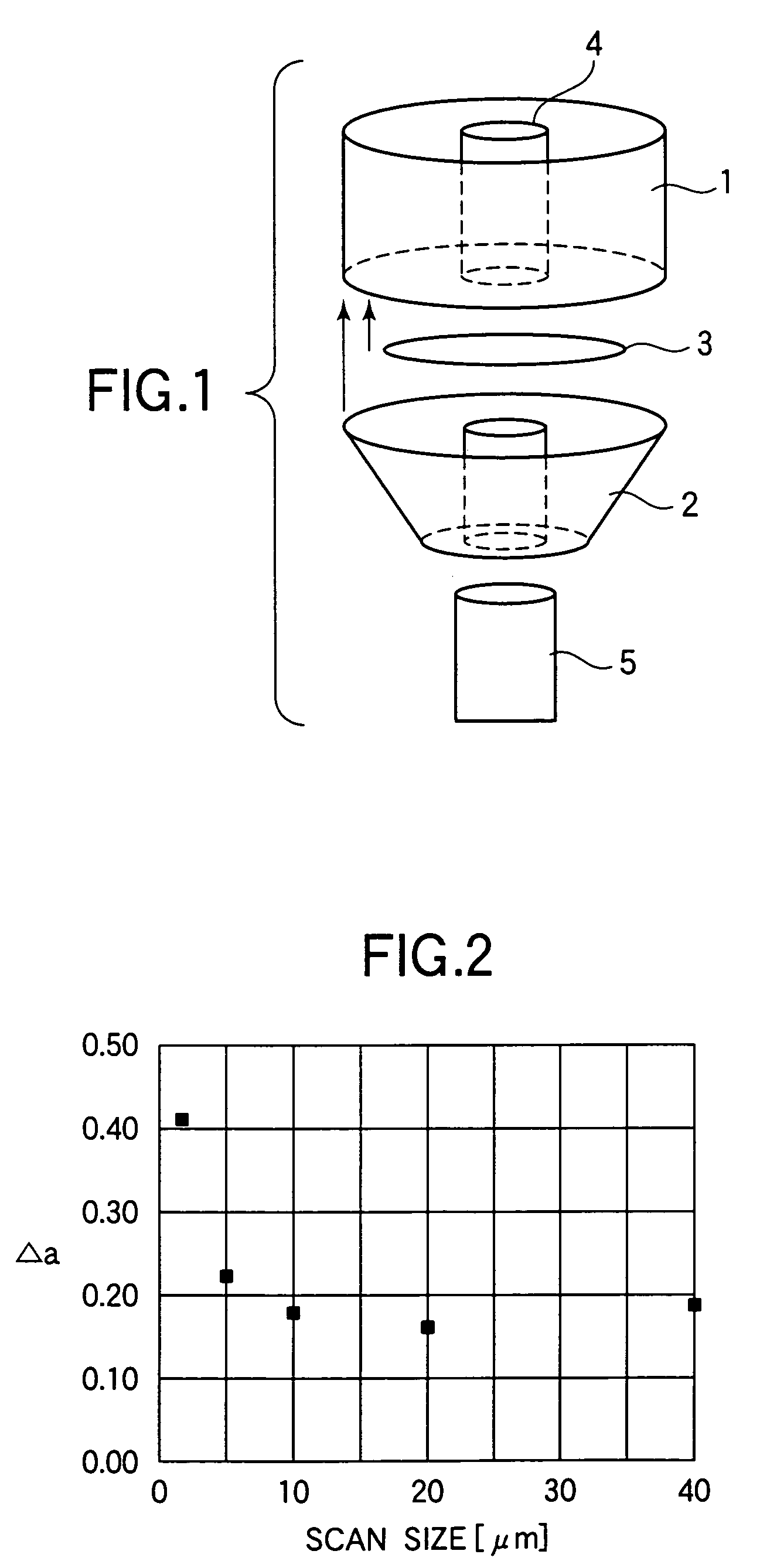Image forming apparatus
a technology of image forming apparatus and forming tube, which is applied in the direction of electrographic process apparatus, instruments, developers, etc., can solve the problems of difficult to completely remove residual toner particles, residual toner particles that have not been removed, and surface scraping that is not easy to achieve, and achieves superior cleaning performance and cleaning performance. , the effect of superior charging stability and running stability
- Summary
- Abstract
- Description
- Claims
- Application Information
AI Technical Summary
Benefits of technology
Problems solved by technology
Method used
Image
Examples
example 1
[0191]
(1) Production of Magnetic Toner(by weight)Polyester resin100 parts(polycondensation product of propylene oxide modifiedbisphenol A with fumaric acid; Tg: 61° C.;Mw: 51,000; Mn: 3,200)Magnetic iron oxide 90 parts(composition: Fe3O4; particle shape: octahedral;average particle diameter: 0.24 μm; Hc: 9.4 kA / m;σs: 82.6 Am2 / kg; σr: 12.0 Am2 / kg)Azo metal complex 2 parts(available from Hodogaya Chemical Co., Ltd.;trade name: T-77)Fischer-Tropsch wax 5 parts(available from Nippon Seiro Co., Ltd.; trade name:FT-100; DSC maximum endothermic peak temperature:98° C.)
[0192]Materials formulated as shown above were well mixed using a Henschel mixer (FM-75 Type, manufactured by Mitsui Miike Engineering Corporation). Thereafter, the mixture obtained was kneaded by means of a twin-screw kneader (PCM-30 Type, manufactured by Ikegai Corp.) set to a temperature of 130° C. The kneaded product obtained was cooled, and then crushed by means of a hammer mill to a size of 1 mm or less to obtain Crushe...
example 2
[0225]In Production of Magnetic Toner in Example 1, Crushed Product A-1 was obtained by the same procedure. Thereafter, it was finely pulverized using Turbo Mill T-250 Type. When it was finely pulverized, pulverization feed rate was made higher by 5% and the number of revolutions of the rotor of T-250 was made lower by 5% in respect to those in Example 1. The finely pulverized product obtained by pulverization was further classified by means of an air classifier in the same manner as in Example 1 to obtain Magnetic Toner Particles B-2 with a weight-average particle diameter (D4) of 8.3 μm and an average circularity of 0.917 in 3 μm or larger particles.
[0226]Next, of fine powder and coarse powder obtained simultaneously in this classification step, the coarse powder was taken to remove its coarse particles by means of an air sifter (High Bolter NR-300 Type, manufactured by Shin Tokyo Kikai K.K.) to obtain Magnetic Particles C-2 with an average circularity of 0.907. Here, a mesh with ...
example 3
[0228]Magnetic Toner Particles B-3 with a weight-average particle diameter (D4) of 5.3 μm and an average circularity of 0.930 in 3 μm or larger particles were obtained in the same manner as in Production of Magnetic Toner in Example 1 except that, when finely pulverized by means of Turbo Mill T-250 Type, pulverization feed rate was made lower by 5% and the number of revolutions of the rotor of T-250 was made higher by 5% in respect to those in Example 1.
[0229]To Magnetic Toner Particles B-3, Magnetic Particles C-1 obtained in Example 1 were little by little so added and mixed that magnetic particles contained in 5 g of toner to be prepared came to 30 particles or thereabout, counting the particles by means of the measuring device having a mesh with an opening of 34 μm. To the mixture obtained, hydrophobic fine silica powder and strontium titanate were externally added in the same manner as in Example 1, and these were introduced into Gyro Sifter to carry out sifting to obtain Magnet...
PUM
 Login to View More
Login to View More Abstract
Description
Claims
Application Information
 Login to View More
Login to View More - R&D
- Intellectual Property
- Life Sciences
- Materials
- Tech Scout
- Unparalleled Data Quality
- Higher Quality Content
- 60% Fewer Hallucinations
Browse by: Latest US Patents, China's latest patents, Technical Efficacy Thesaurus, Application Domain, Technology Topic, Popular Technical Reports.
© 2025 PatSnap. All rights reserved.Legal|Privacy policy|Modern Slavery Act Transparency Statement|Sitemap|About US| Contact US: help@patsnap.com



